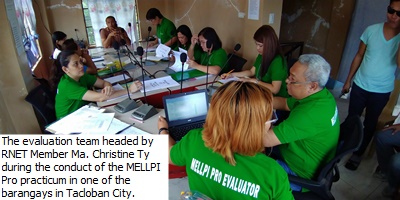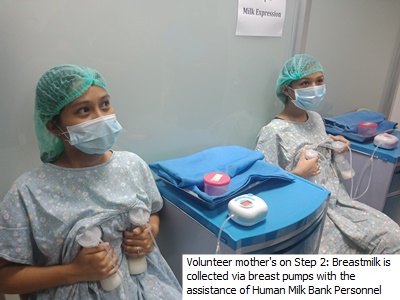Featured Videos
News
- Details
- Written by Aivan Lloyd Calonia, DOST VIII
- Category: News
- Hits: 1242
 |
| In photo: Dr. Rufino E. Mengote, ARD of FAS led his unit in planting pechay and squash. |
Women holding multiple roles both in household and in their day jobs are having less or no time taking notes of their health and well-being. Their preoccupation to these responsibilities has made it hard for them to remain well-conditioned to continue juggling all the roles they have including dismantling systemic inequalities which hinder access to economic, social and political opportunities.
In line with this and in the nationwide observance of the celebration of the women’s month, the GAD (Gender and Development) Program of DOST VIII in its aim to enable an environment where employees appreciate and discuss gender-related issues, launched an intervention program which would encourage men and women in the organization to involve themselves in a gardening management activity that would in turn develop consciousness on the importance of nutrition and taking due attention to overall well-being.
The units in the regional office- FAS, TO and RSTL were allocated a certain area where they can plant vegetables including pechay , squash, and okra. There were also fertilizers provided.
The health and nutrition program also aims to develop teamwork, and promote shared responsibility among the employees.
- Details
- Written by National Nutrition Council RO VIII
- Category: News
- Hits: 4298

TACLOBAN CITY – Thirty-six Nutrition Stakeholders from Eastern Visayas region actively involved in the yearly conduct of Monitoring and Evaluation of Local Level Plan Implementation (MELLPI) on nutrition programs and services gathered for a two-day roll-out training on the updated monitoring and evaluation protocol on nutrition dubbed “MELLPI Pro” on Mach 6-7, 2019 at the Commission on Audit (COA) Training Center, Palo, Leyte.
Attendees to the training were representatives from government agencies who are members of the Regional Nutrition Evaluation Team (RNET), Provincial Nutrition Action Officers (PNAO), District/City Nutrition Program Coordinators (D/CNPC), City and Municipal Nutrition Action Officers (C/MNAO), and some members of National Nutrition Council Region VIII (NNC-8) media-group partner Harmonized Initiatives of Media for the Spread of Good Nutrition in Region 8 (HIMSoG-8).
MELLPI Pro replaces the traditional MELLPI, the nutrition programs implementation assessment tool for localities adopted in the 80s. The said upgraded system emphasis: a) assessment of LGUs’ progress toward compliance to quality standards, b) evidence-based validation, and c) mentoring through joint discussion for learning and action discussion with LGU or nutrition worker assessed. A new feature (of MELLPI Pro) is the Performance Assessment of Nutrition Workers namely: Nutrition Action Officers, District/City Nutrition Program Coordinators and Barangay Nutrition Scholars (BNSs).
This new protocol connoting professional, progressive, promotional, process, and profitable is for full implementation by 2020--with this year (2019) as the transition period. By then under MELLPI Pro all local government units (LGUs) and their corresponding nutrition workers nationwide shall undergo assessment and evaluation:
At the regional level, the Regional NutritionEvaluation Team (RNET) shall visit all provinces and highly-urbanized and independent cities; at the provincial level, the Provincial Evaluation Team (PET) shall visit all municipalities and component cities; at the city and municipal level, the City/Municipal Evaluation Teams (C/MET) shall visit all barangays. Meanwhile, the National Nutrition Evaluation Team (NNET) shall evaluate the National Honor Award (NHA), and the 1st and 2nd Year CROWN Maintenance Contenders.
- Details
- Written by National Nutrition Council RO VIII
- Category: News
- Hits: 2097

Tacloban City-The first built human milk bank in the Visayas was inaugurated on February 28, 2019, at the Reproductive Health and Neonatal Center, Eastern Visayas Regional Medical Center (EVRMC), Tacloban City.
As part of the UNICEF’s commitment of building back better after Super Typhoon Yolanda, human breastmilk will now be available not only in usual time but also during and after disasters. UNICEF Chief of Health and Nutrition Dr. Wigdan Magdani said that in an area prone to disaster, high incidence of infant mortality is recorded.
With the state of measles outbreak, Department of Health, Assistant Regional Director Dr. Exuperia Sabalberino calls for a multi-sectoral campaign on breastfeeding. Breastfeeding is more than nutrition, it is a good life-saving method, ARD Sabalberino added.
Breastmilk is the best food offered to infants with all the nourishment needed in the first six (6) months of life. Accordingly, it is safe, clean, easily-digestible and in most cases the only available ready food from the mother.
- Details
- Written by Philippine Information Agency RO VIII
- Category: News
- Hits: 1112
 |
| HIV/AIDS orientation conducted among Philippine Information Agency employees by the Quezon City Government. |
The Philippines has been reported to be one of the fastest growing worldwide in terms of rate of increase in infections of HIV/AIDS with a reported 56,275 cumulative cases since 1984 by the Department of Health AIDS Registry. The same data shows, however, that the Philippines is also a low-HIV-prevalence country, with less than 0.1 percent of the adult population estimated to be HIV-positive.
According to Quezon City Public Health Department Medical Officer Dr. Angel Mendoza, the increase in the Philippines’ yearly status on Human Immunodeficiency Virus (HIV) and Acquired Immune Deficiency Syndrome (AIDS) cases rise to about 170 percent. As of November 2018, approximately one to two Filipinos are diagnosed as positive in an hour. The medical practitioner conducted an HIV/AIDS orientation to employees of the Philippine Information Agency courtesy of its Human Resource and Development Division.

Mendoza said the city’s high percentages of Persons Living with HIV (PLHIV) are those in the age range of 15-24 year old.
“These are mostly students and those working in different industries,” he said, adding that they may be prone to experience discriminatory acts in the workplace, in their learning institutions, and even while availing some form of insurance coverage, simply because the level of awareness of some individuals are still on the low side.
He said the fight against HIV/AIDS has been made more difficult due to the latest industrial developments like easier access to social media that may have contributed to an increased number of unprotected sex and eventually, to the virus spread.
The irresponsible sharing of some social media posts online also contributes to the confusion as commonly read HIV-related stigma content relating to HIV transmission, as well as hoax medicinal remedies to HIV/AIDS can be easily shared.
These are the kinds of information we would want to contain and stop from disseminating, he said.
Mendoza said being misinformed about HIV such as its symptoms, prevention, and treatment may contribute to the rapid spread of infection among the young population.
The official shared that in the Philippines, Quezon City has the highest number of PLHIV diagnosed garnering 64 percent, followed by Caloocan City with 7 percent.
“The only way to know your status is to get tested. HIV testing is recommended as a standard care for all sexually active individual to ensure HIV prevention as well as immediate treatment and care,” Mendoza said.
- Details
- Written by Administrator
- Category: News
- Hits: 1185
Last 27th of February 2019, the Eastern Visayas Health Research and Development Consortium (EVHRDC) conducted a turn-over of financial grant for Ms. Inish Cris Mesias at the Office of the Vice-President for Instructions in VSU Main Campus, Baybay, Leyte cum Monitoring of RRF-funded Project of Dr. Lilibeth Miralles in VSU Alangalang Campus.
Ms. Mesias of VSU Main Campus will be undertaking her research project entitled "Assessment of the Prevalence of Foodborne Pathogens from Meat-Based Street Foods in Selected Cities of Leyte."
 |
| The turnover was graced by Dr. Beatriz Belonias, Vice President for Instruction and OIC-Office of the President at the time, Ms. Inish Cris Mesias, the researcher, and the EVHRDC Team: Dr. Lucia P. Dauz, Ms. Rachelle Mae B.Arape, and Ms. Jessamay C. Mercado. |
The turnover was followed by the project monitoring for the study of Dr. Lilibeth G. Miralles entitled "Community risk factors on the Occurrence and Prevention of diarrhea outbreak in Eastern Visayas: A case-control study."
 |
| (L-R) Present during the monitoring meeting was the co-investigator of Dr. Miralles – Ms. Alena Gonzaga, Ms. Mercado, Ms. Arape, Dr. Manuel Rona – Dean of College, Dr. Dauz, and Dr. Miralles. |
With only a few minor problems encountered, Dr. Miralles gave satisfactory updates on the technical and financial aspect of her research project and informed the team on her next steps towards the completion of the research project.








